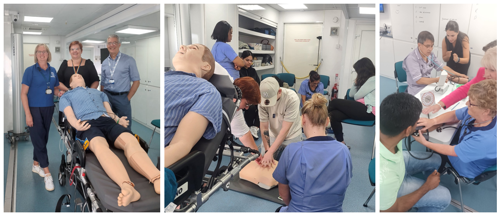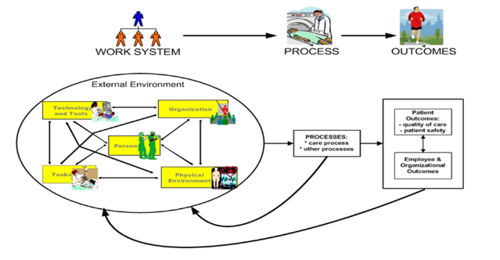Mobile Skills Unit Update

August was another busy month for the Mobile Skills Unit. It began with a visit to Rubislaw Care Home in Aberdeen for the first ever visit to a care home in Scotland. In collaboration with NHS Grampian, NHS Scotland Academy and the University of Aberdeen, Ashley Meldrum, Senior Clinical Educator (North), delivered an intensive three days of simulation training to carers, senior carers and team leaders. Training included:
- Signs of deterioration within residents and the Restore Tool
- Simulated scenarios
- Communication skills - SBARD
- Venepuncture and blood sugar
- Cannulation s/c injections and IM injections
- Wound care and dressings
- CPR, AED, Basics airway manoeuvres and choking.
Some excellent feedback from the participants:
“Excellent, informative and immersive training session. Refreshing skills and learning most recent gold standard in practice. Fun and relaxing environment, encouraging informal discussion between professionals. Multidisciplinary working, fantastic to have SAS participation.”
“Fabulous immersive training, allowing me to experience sensory deprivation and tremor, giving a more empathetic understanding to my daily working practice.”
“Understand more how to work with residents with different issues.”
“It has updated my skills on Venepuncture, Catheterisation, First Aid, CPR and choking.”
From care homes to Scottish Rugby the MSU also visited Highland RFC & Falkirk RFC for more training in pre-hospital pitch side care and BLS/ALS and AED for first aiders and those involved in providing immediate care.
From Scottish Rugby to the University of Highlands & Islands in Inverness for NHS 24 staff training the MSU ended the month at the Old Mart Resource Centre in Maud. The Practice Education & Development Team in NHS Grampian delivered the training programme in Maud, training included:
- Deteriorating Patient in a Community Setting,
- Managing Heart Failure in Community Settings
- Mental Health Awareness.
Maud Primary School P7’s also got the chance to visit!
The Mobile Skills Unit truly is a multi-professional and multi-agency resource. If you are thinking of booking the Mobile Skills Unit for your region you can check out the MSU availability on this calendar.
We are excited to announce that the Mobile Skills Unit will be at the NP/APN Network Conference from 9 September to 12 September in Aberdeen. This conference will provide the largest global forum for advanced practice nurses to network and collaborate on contemporary topics and future trends relevant to their practice. If you are at the conference, make sure you come and visit the Mobile Skills Unit and meet the CSMEN team!
Medical Simulation Training
This month sees the start of the new training year for our medical trainees. A range of Bootcamps for Core Surgery, Ophthalmology and Microbiology trainees have been delivered in the Highlands, Lothian and Fife areas as well as Critical Care Skills and Simulation Training days at the Suttie Centre, Aberdeen and at Kirkland’s, Lanarkshire and the first of Internal Medical Training Skills day at the Royal College of Physicians and Surgeons, Glasgow.
SEIPS: the ‘Swiss Army Knife’ of Human Factors
The Systems Engineering Initiative for Patient Safety (SEIPS, pronounced ‘SEEPS’) framework is arguably the most popular and flexible Human Factors tool in healthcare.
The framework is illustrated in Figure 1. Here we can see a generic work system that is applicable to any facility in any healthcare sector (e.g., operating theatre, community pharmacy, ambulance vehicle, mental health ward, open plan offices, staff dining room).
Figure 1. The SEIPS Framework (1)

The focus of the care work system on the left of the diagram is on showing the interactions between people and five other work system elements: job tasks, tools and technology, the physical environment, the organisational of work, and external influences such as safety legislation, regulation, and national targets.
The interactions that take place between these system elements are often complex and combine to create both wanted and unwanted outcomes related to overall performance (e.g. system safety, efficiency) and human wellbeing (e.g. patient safety, staff experience, comfort, joy) that are outlined on the right side of the diagram. This important focus on considering and jointly optimising both performance and wellbeing perfectly echoes the ‘twin aims’ of what human factors as a discipline always seeks to achieve. Indeed, it is one of the distinguishing features of the human factors approach compared with other disciplines.
SEIPS is strongly recommended because it is highly evidence-based in health services research and evaluation. However, it has arguably even greater potential as an accessible and flexible entry-level Human Factors tool for those at the ‘sharp end’ of care practice.
For example:
It can be applied by healthcare practitioners to:
- Analyse safety incidents and complaints,
- Develop and test standard operating procedures and protocols,
- Better understand systemic issues influencing workforce performance and wellbeing,
- Inform care system redesigns,
- Help design quality improvement interventions,
- Graphically illustrate a ‘system story’ to senior leaders.
It can be applied by simulation educators to:
- Design more meaningful simulation scenarios,
- Practise systems-based hazard identification, risk assessment and control,
- Guide in situ walk-thru-talk-thru analysis to more meaningfully understand work system complexities
It can be applied by clinical educators to:
- Teach basic Human Factors science,
- Teach the basics of safety learning and complaints reviews using case studies,
- Teach the basic ‘systems approach’ to everyday problem-solving.
It can be applied by researchers to diverse studies, including literature reviews, to:
- Deductively analyse systemic factors and interactions influencing healthcare performance issues e.g. increased infection control cases, work-related stress, co-design and test a safety checklist, or identify and analyse the strength of safety controls in specific clinical environments.
Informed by the SEIPS framework, the NES Human Factors team has developed a practical worksheet tool with brief guiding notes that can be adapted for use by educators, clinical practitioners, researchers, and improvement, safety and risk advisors.
To access the Care System Analysis Tool (CSAT), please click here.
If interested in learning more or testing out the tool, please contact
Paul Bowie PhD C.ErgHF, NES Programme Director, Chartered Ergonomist and Human Factors specialist
X/Twitter: @hfhealthcareuk @pbnes
Bibliography
Carayon P, Schoofs Hundt A, Karsh BT, Gurses AP, Alvarado CJ, Smith M, Flatley Brennan P. Work system design for patient safety: the SEIPS model. Qual Saf Health Care. 2006 Dec;15 Suppl 1(Suppl 1
Human Factors for Healthcare

CSMEN Clinical Lead Catie Paton is co- editor of ‘Human factors for Healthcare: A Guide for Nurses and Allied Health Professionals.’ The aim of the book is to support understanding of human factors and the role they play in quality and safety. Chapters include communication; Teamwork; Leadership; Situation Awareness and Decision Making; Workplace culture; Stress and fatigue; and Resilience.
You can find the full list of contributors and read an excerpt here.
BASICS Scotland Update
Please refer to the BASICS Scotland website for all course dates.
DIHS Scotland Update
DIHS Surgical Skills Centre, Level 5, Ninewells Hospital have confirmed many new course dates for the coming months. For further information, including an online registration form, please visit the DIHS website.
SCSCHF Update
Please refer to the SCSCHF website for all course dates.
Conferences
You can find a link to conferences relevant to clinical skills and simulation here.
Resources
A range of resources to help you deliver simulation-based education can be found here.
